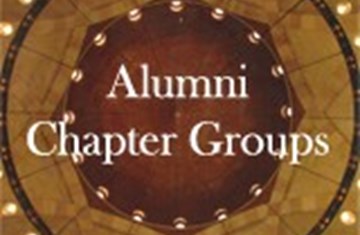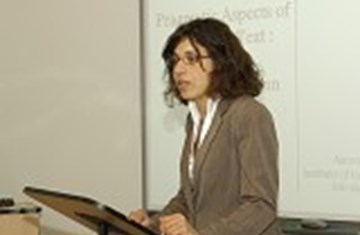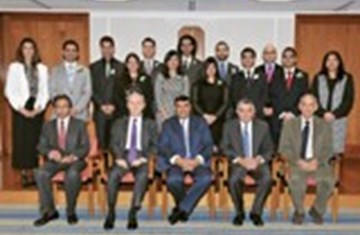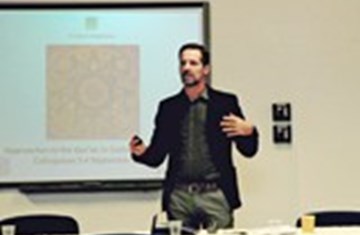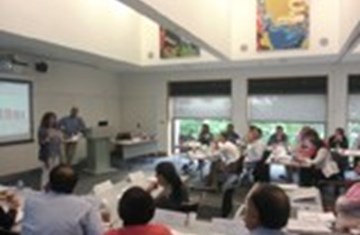IIS Co-Sponsors Conference on The Gwalior Qur’an Manuscript: The Polysemy of an Illuminated Codex

The Qur’anic Studies Unit of the IIS co-sponsored a conference entitled Autour du Coran de Gwalior: polysémie d’un manuscrit à peintures (The Gwalior Quran Manuscript: The Polysemy of an Illuminated Codex) which took place at the Bibliothèque Nationale de France and the Institut national d'histoire de l'art (INHA) in Paris.
The manuscript at the centre of the conference is a complete copy of the Qur’an found in Gwalior, India, and dated to the fourteenth century. The importance of this manuscript lies in its rich decoration and the complexity of its textual structure. A large portion of the Qur’anic text contains an interlinear Persian translation. The manuscript ends with a book of divination (fal nama) on how to read the Qur’an to find out auguries and omens. The conference was multidisciplinary, bringing together scholars who have been approaching this fascinating manuscript from various different specialisations as part of a four-year collaborative research programme at the unité mixte de recherche (UMR) 8167 ‘Orient et Méditerranée – Laboratoire Islam médiéval’.
The conference was introduced by the organiser, Éloïse Brac de la Perrière from the University of Paris – Sorbonne, after opening remarks from Heather Ecker (Head of Curatorial Affairs at the Aga Khan Museum Project in Toronto), Jean-Pierre Van Staëvel (Professor of Archaeology and History of Islamic Arts at the University of Paris – Sorbonne) and Omar Ali-de-Unzaga (Academic Coordinator of the Qur’anic Studies Unit at The Institute of Ismaili Studies).
The conference was divided into four sessions. During the first session (‘The Gwalior Qur’an Manuscript as an objet d’art’), the variety of decorative techniques used in the Gwalior Qur'an manuscript was explored. Papers in the second session (‘The Gwalior Qur’an Manuscript and Indo-Persian Manuscripts’) explored the repertoire of graphic styles adopted in the redaction of the Gwalior Qur’an manuscript, as well as the circulation of the artistic motifs between China and India during the Sultanates period. The work was compared to other manuscripts coming from similar periods and locations.
The third session (‘The Gwalior Qur’an Manuscript as an Object of Knowledge’) showed the functions of the divinatory book at the end of the manuscript in the context of other divination manuscripts, many of which were produced in Safavid Iran and attributed to the Shi‘i Imams ‘Ali b. Abi Talib or Ja‘far al-Sadiq. In her paper, Asma Hilali, Research Associate in the Qur’anic Studies Unit at the IIS, discussed the mixture of religious texts in the circles of religious teaching in the formative period of Islam. The second part of her paper was dedicated to the oldest manuscript of the Qur’an and its importance in showing the confusion of textual genres in the circles of transmission.
In the last session of the conference (on ‘Contexts’), presentations dealt with the Muslim presence in Gwalior and in India before the sixteenth century as well as the artistic taste of Indo-Persian elites during that period. They also explored the patronage of knowledge during the pre-Mughal period and the issue of the production of religious literature.
With its multidisciplinary approach, the conference provided wide-ranging perspectives on the Gwalior Qur’an Manuscript in its artistic and textual aspects. Many of the discussions dealt with the issue of how this manuscript was produced and used, and highlighted that the manuscript is a witness to various Islamic and non-Islamic traditions of painting and book-composition. In this respect, the Gwalior Qur’an manuscript constitutes a fundamental monument in Indo-Persian Islamic culture.
The Institute of Ismaili Studies co-sponsored this conference in partnership with other institutions, mainly ‘Orient et Méditerranée’, Laboratoire Islam médiéval, unité mixte de recherché (UMR) 8167 and ‘Mondes iranien et indien’, unité mixte de recherche (UMR) 7528. Other supporting institutions included the Aga Khan Trust for Culture; the University of Paris – Sorbonne; the Bibliothèque Nationale de France, Paris; the Laboratoire d’excellence ‘Religion et Sociétés dans le Monde Méditerranéen’ (Labex RESMED) and the Museé des Beaux Arts, Orléans.
Related Pages on the IIS Website:
- Seminars and Conferences: The Gwalior Qur’an Manuscript
Gallery: Khojki Manuscripts


